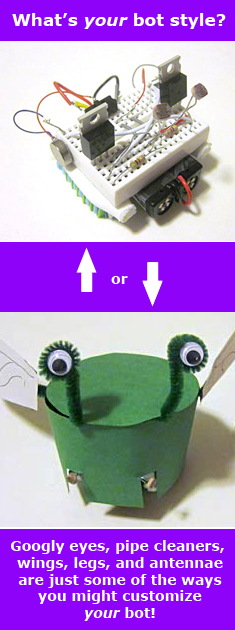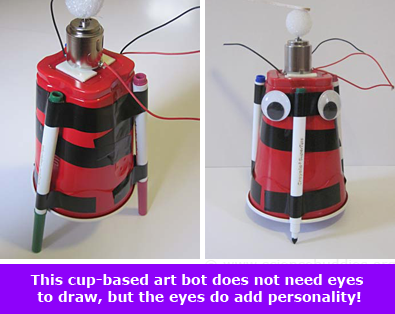Create a Carnival of Robot Critters this Summer
With a bit of planning, you can stock up on materials your students can use to create a cadre of cool robotic animals, bugs, and creatures this summer. Upcycled vibrating motors may be your best friend for inspiring hands-on engineering with your kids, but there are plenty of ways to turn off-the-shelf bots and the Mindstorms® kit you may already own into a foundation for fun summer science with a friendly "critter" twist.

Planning Summer Science
As I iron out plans for hands-on summer science activities and projects to both engage and occupy my kids during long summer days, I have been watching the stream of new and exciting Project Ideas being added to the Science Buddies robotics area. Bristlebots are a must-make for us this summer. It's a logical starting point, and it turns the familiar hex- and nano-bug concept we already know into a DIY activity. We can make them.
Jumping in with Bristlebots
Bristlebots are a great way to start kids off on a simple robotics engineering project—one you can pretty much guarantee will succeed. There is minimal wiring, a minimal number of parts, and for parents who worry about not having expertise to guide a robotics project, there are minimal steps where you (or the kids) might get off track. When it boils down to it, make sure you have one wire from the motor touching the top and one wire touching the bottom of the battery, and you are all set. If you decide to get industrious and salvage vibrating motors from the junk electronics drawer in your house, you up the challenge a notch (you might have to attach the wires), but the level of difficulty is still minimal—and the fun and sense of general robotics accomplishment pretty big.
Bristlebots, first introduced by Evil Mad Scientist Laboratories, are a great launching point. A Bristlebot doesn't take long to make, and once made and set loose on a table, these little bots will take off on their bristly legs and be bounced around and redirected by hands or makeshift habitat walls.
But once those bots are scuttling around, chances are that you—or, more to the point, your kids—are going to want more.
You can extend the life of your bristlebot exploration by experimenting with different brush heads (as our Project Idea suggests), or by constructing ramps, mazes, and tunnels. But older elementary kids will surely want to kick things up a notch. They are going to have ideas about solar panels, about adding more brushes, about giving the bot more power, and about enabling remote control. Encouraging their thinking and innovation is important, and having some additional related projects up your sleeve to satiate and encourage their curiosity and desire to tinker, build, and make may find you and your kids breezing through a robot-inspired summer.
Robot Critters
Bugs, critters, pets, pals... call them what you will, but many student robotics projects generate small bots that skitter around, much like an insect.

How you and your kids customize a robot is completely up to you. If one day your daughter really wants a bristlebot that looks like a ladybug, it's doable. The same bot can be re-dressed another day to look entirely different. What's going on beneath the costume is where most of the exciting hands-on construction happens. But customizing a bot to make it "just right for its creator" is a step that brings hands-on engineering full circle for some creative-minded kids.
Here are a few robotics projects you can adapt to do with your students this summer as hands-on science and engineering activities at home:
- Art Bot: Build a Wobbly Robot Friend That Creates Art: this bot is built from a plastic cup. Adding googly eyes to give the artist robot personality may be just the beginning! The full project has students explore how to guide the movements of the bot by adjusting the weights on top of the bot's head. For summer family fun, a basic art bot might be enough to kick start interest. (Grades K-3)
- Racing BristleBots: On Your Mark. Get Set. Go!: an introductory exploration of bristlebots, this project walks you through the basics and sets the stage for future bristle-based bot experiments. Masking the bot's toothbrush origins isn't covered in the project, but that doesn't mean you can't turn yours into something uniquely your own! (Grades K-3)
- The Frightened Grasshopper: Explore Electronics & Solar Energy with a Solar-Powered Robot Bug: this exploration uses a ready-made bot, but it gives students the opportunity to investigate solar energy—and whether or not artificial light works for solar-powered critters and devices. With what your student learns in this project, she might have ideas for taking another basic bot in a new, sun-friendly, direction. (Grades 4-5)
- Take a Hike: Train Your Robot Dog to Walk with a Virtual Leash: this project involves building a LEGO® Mindstorms® robot and programming the bot's sensors to respond to light so that you can "walk" your pet by controlling a light source, like a flashlight. If you already have the Mindstorms system, this is a great programming-based challenge for your builder. (Grades 6-8)
- Build a Light-Tracking Robot Critter: transform a regular bristlebot robot into a bot that you can guide around with a flashlight. This robot uses two toothbrush heads, two motors, and two light sensors and involves a more sophisticated circuit using a small breadboard. Bring on the tinkerers! (Grades 9-12)
The projects above are arranged in order of difficulty because when it comes to engineering, electronics, and robotics, your students will often learn in a stepwise manner, building upon skills introduced and used in one project when they move on to the next, slightly more difficult, project. All kids differ, but the general grade range for these projects are noted. Tinker-savvy kids can still enjoy the less difficult projects, and with adult involvement, younger students can certainly join in on projects pegged as appropriate for independent science fair engineering projects for older students.
Why not try them all!
Show Off Your Bots!
We would love to see the bots you and your students create this summer. Send us a photo, and we might share your bots on the blog or one of our other community spots!
Categories:
You Might Also Enjoy These Related Posts:
- 15 STEM Gifts & Science Kits You'll Feel Good About Giving
- 13 Boat Science and Submarine Science Projects and Experiments
- July 4th STEM! Summer Science Picks for Independence Day!
- 12 Science Kits for Summer Science Experiments and Discovery
- 15 Science Projects to Make and Give for Father's Day
- Ready, Set, Go! (Awesome Summer Science Experiments)
- Awesome Summer Science Experiments
- 10 STEM Activities with Cardboard Tubes









